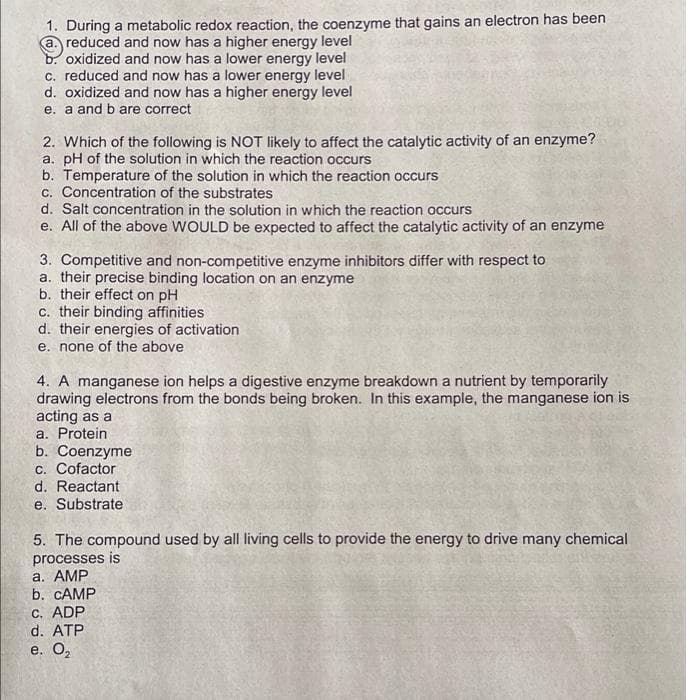1. During a metabolic redox reaction, the coenzyme that gains an electron has been a reduced and now has a higher energy level oxidized and now has a lower energy level c. reduced and now has a lower energy level d. oxidized and now has a higher energy level e. a and bare correct
1. During a metabolic redox reaction, the coenzyme that gains an electron has been a reduced and now has a higher energy level oxidized and now has a lower energy level c. reduced and now has a lower energy level d. oxidized and now has a higher energy level e. a and bare correct
Biology 2e
2nd Edition
ISBN:9781947172517
Author:Matthew Douglas, Jung Choi, Mary Ann Clark
Publisher:Matthew Douglas, Jung Choi, Mary Ann Clark
Chapter6: Metabolism
Section: Chapter Questions
Problem 7RQ: Which of the following comparisons or contrasts between endergonic and exergonic reactions is false?...
Related questions
Question
Please answer fast

Transcribed Image Text:1. During a metabolic redox reaction, the coenzyme that gains an electron has been
a. reduced and now has a higher energy level
b. oxidized and now has a lower energy level
c. reduced and now has a lower energy level
d. oxidized and now has a higher energy level
e. a and b are correct
2. Which of the following is NOT likely to affect the catalytic activity of an enzyme?
a. pH of the solution in which the reaction occurs
b. Temperature of the solution in which the reaction occurs
c. Concentration of the substrates
d. Salt concentration in the solution in which the reaction occurs
e. All of the above WOULD be expected to affect the catalytic activity of an enzyme
3. Competitive and non-competitive enzyme inhibitors differ with respect to
a. their precise binding location on an enzyme
b. their effect on pH
c. their binding affinities
d. their energies of activation
e. none of the above
4. A manganese ion helps a digestive enzyme breakdown a nutrient by temporarily
drawing electrons from the bonds being broken. In this example, the manganese ion is
acting as a
a. Protein
b. Coenzyme
c. Cofactor
d. Reactant
e. Substrate
5. The compound used by all living cells to provide the energy to drive many chemical
processes is
a. AMP
b. CAMP
C. ADP
d. ATP
e. О,
Expert Solution
This question has been solved!
Explore an expertly crafted, step-by-step solution for a thorough understanding of key concepts.
Step by step
Solved in 4 steps

Recommended textbooks for you

Biology 2e
Biology
ISBN:
9781947172517
Author:
Matthew Douglas, Jung Choi, Mary Ann Clark
Publisher:
OpenStax

Biology: The Dynamic Science (MindTap Course List)
Biology
ISBN:
9781305389892
Author:
Peter J. Russell, Paul E. Hertz, Beverly McMillan
Publisher:
Cengage Learning

Biology (MindTap Course List)
Biology
ISBN:
9781337392938
Author:
Eldra Solomon, Charles Martin, Diana W. Martin, Linda R. Berg
Publisher:
Cengage Learning

Biology 2e
Biology
ISBN:
9781947172517
Author:
Matthew Douglas, Jung Choi, Mary Ann Clark
Publisher:
OpenStax

Biology: The Dynamic Science (MindTap Course List)
Biology
ISBN:
9781305389892
Author:
Peter J. Russell, Paul E. Hertz, Beverly McMillan
Publisher:
Cengage Learning

Biology (MindTap Course List)
Biology
ISBN:
9781337392938
Author:
Eldra Solomon, Charles Martin, Diana W. Martin, Linda R. Berg
Publisher:
Cengage Learning

Biology: The Unity and Diversity of Life (MindTap…
Biology
ISBN:
9781337408332
Author:
Cecie Starr, Ralph Taggart, Christine Evers, Lisa Starr
Publisher:
Cengage Learning